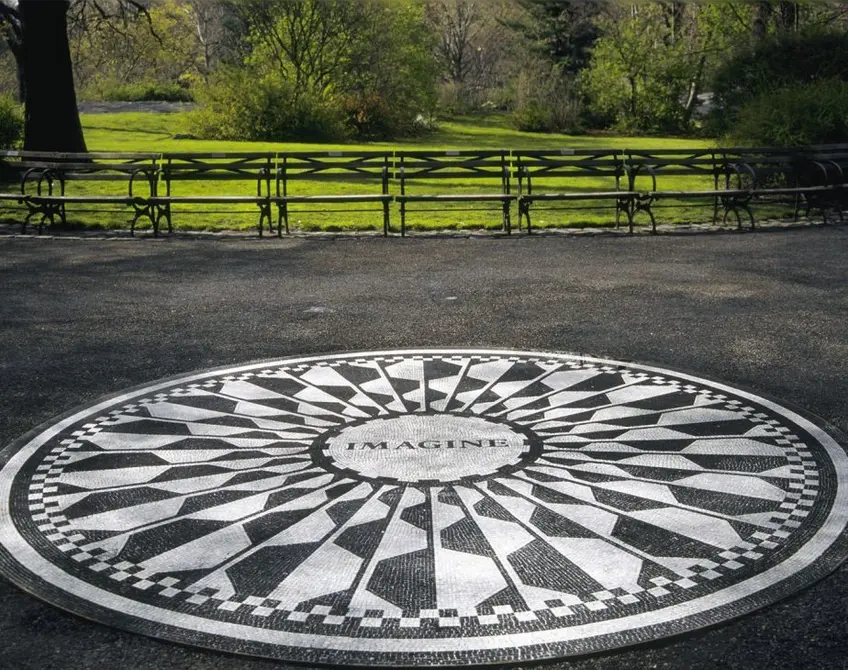 Strawberry Fields mosaic via Central Park Conservancy
Strawberry Fields mosaic via Central Park Conservancy
New Yorkers are nothing if not resilient, but the past spring has proven trying to even the toughest of us. After weeks of sheltering in place to flatten the curve of the coronavirus pandemic, the city was roiled by protests against police brutality and systemic racism sparked by the murder of George Floyd.
New York's robust art presence cannot help but stir optimism in good times and consolation in bad, and that is especially the case for the following works. While the museums remain closed, artwork in the city's parks and public plazas can still be enjoyed. Put your mask on, keep a safe social distance, and visit these sites for inspiration, solace, and hope.
New York's robust art presence cannot help but stir optimism in good times and consolation in bad, and that is especially the case for the following works. While the museums remain closed, artwork in the city's parks and public plazas can still be enjoyed. Put your mask on, keep a safe social distance, and visit these sites for inspiration, solace, and hope.
At this time of intolerable tragedy and violence, we must all unite in rejecting racism and injustice and commit to building a future of safety, peace, and equity for all. pic.twitter.com/KzJhZNFuog
— @MuseumModernArt (@MuseumModernArt) June 1, 2020
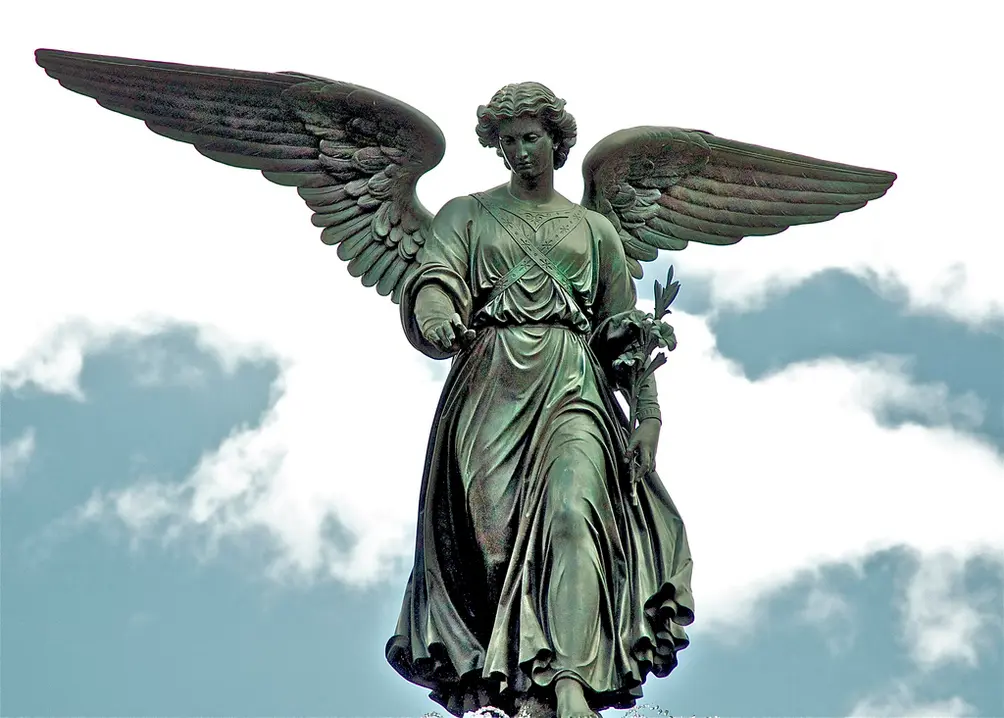 Image via Wiki Commons
Image via Wiki Commons
If you've seen Angels in America or visited the Bethesda Fountain in Central Park, you'll know this artistic masterpiece depicting the Angel of Bethesda. It sits atop a base of four cherubs representing health, purity, peace, and temperance, so as to symbolize the health benefits of the water from the Croton Aquedeuct, which was then stored in Central Park's reservoirs.
What some may not know, however, is that it was New York's earliest public artwork by a woman. Emma Stebbins was living in Rome with her lover, Charlotte Cushman, when the statue was commissioned in 1863. It was cast in Munich and formally dedicated in 1873.
What some may not know, however, is that it was New York's earliest public artwork by a woman. Emma Stebbins was living in Rome with her lover, Charlotte Cushman, when the statue was commissioned in 1863. It was cast in Munich and formally dedicated in 1873.
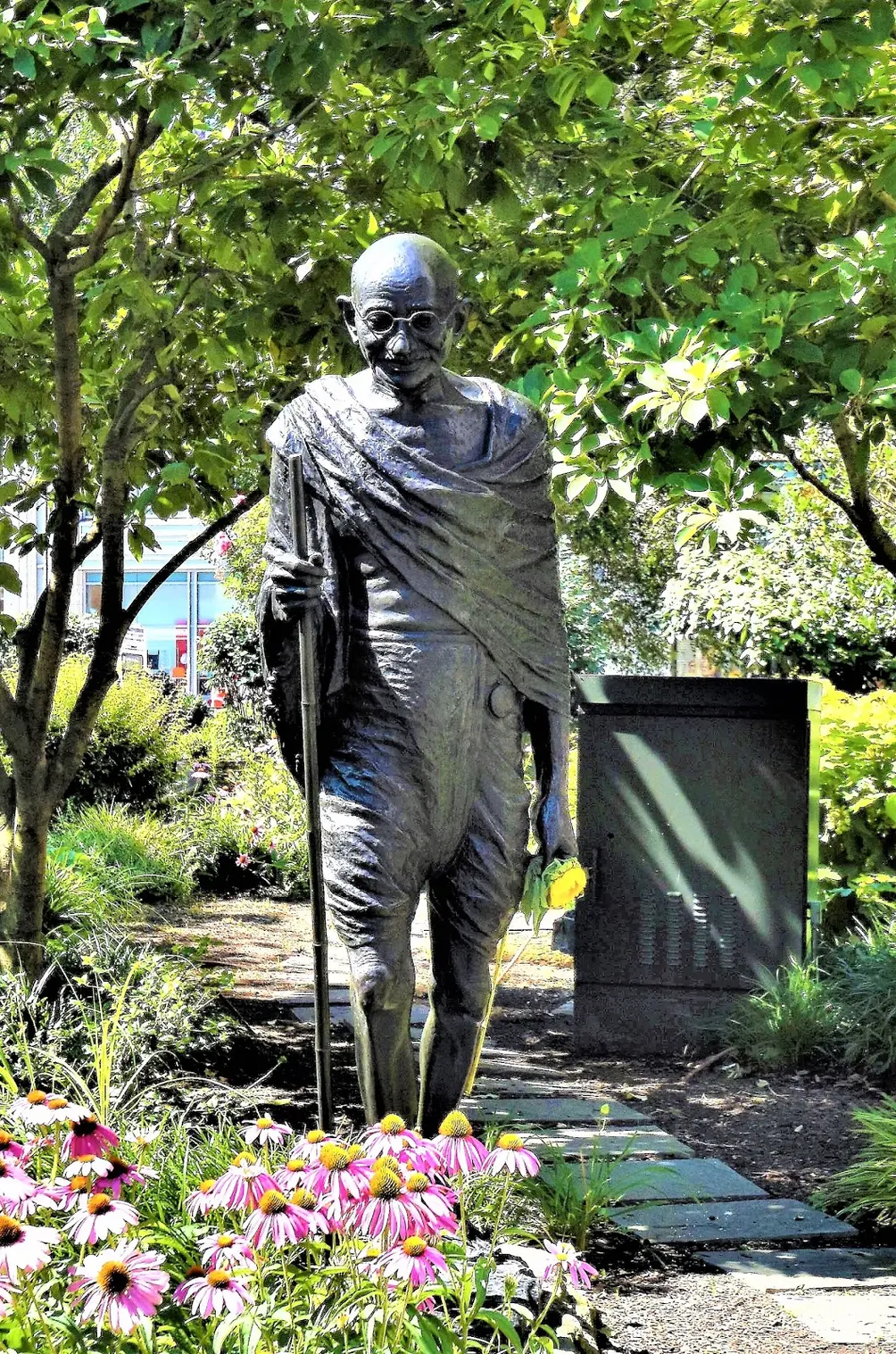 Image via Tom Miller of Daytonian in Manhatta
Image via Tom Miller of Daytonian in Manhatta
Union Square Park is famous for its tradition of protest, and Mohandas Gandhi is remembered as a champion of non-violent protest. To that end, a statue of Gandhi is part of a quartet of works dedicated to defenders of freedom. The Gandhi Memorial International Foundation donated the 8' statue, and civil rights leader Bayard Rustin was the keynote speaker at the dedication ceremony on October 2, 1986 (the 117th anniversary of Gandhi's birth).
The statue was temporarily removed to facilitate the construction of a water main beneath the site, and was conserved in 2001. It was re-set on a more natural stone base in 2002. The landscaped area surrounding it is known as Gandhi Gardens, and the statue can often be seen with floral garlands from visitors around its neck.
The statue was temporarily removed to facilitate the construction of a water main beneath the site, and was conserved in 2001. It was re-set on a more natural stone base in 2002. The landscaped area surrounding it is known as Gandhi Gardens, and the statue can often be seen with floral garlands from visitors around its neck.
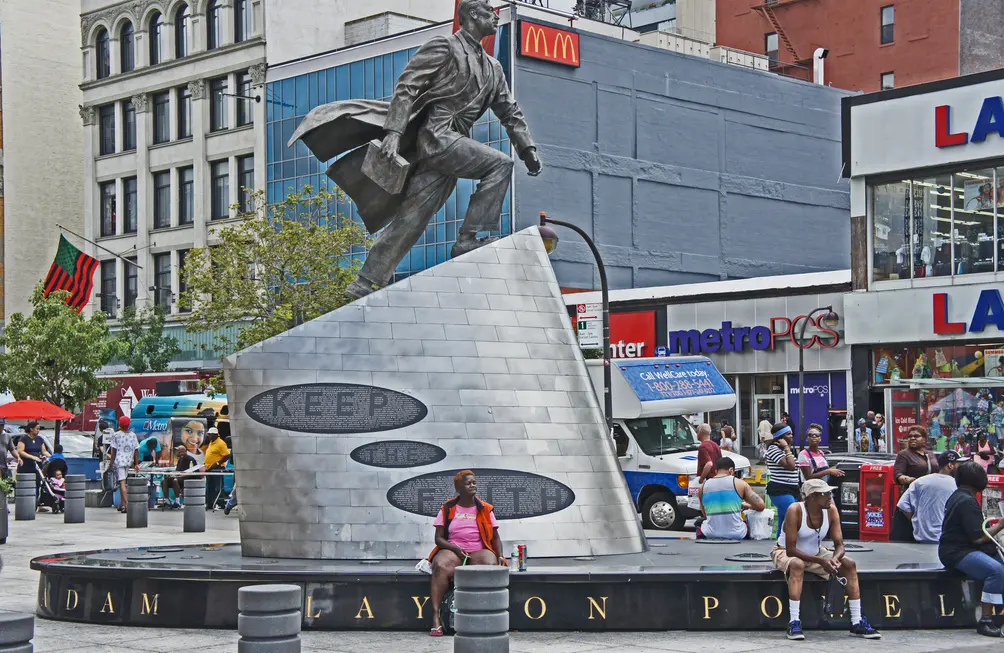 Image via Flickr user dog97209
Image via Flickr user dog97209
North of Central Park, Seventh Avenue has been named in honor of Adam Clayton Powell Jr., the first African-American man from New York to be elected to Congress. In the heart of Harlem, a 12' sculpture of the man himself can be found at 125th Street in a public plaza in front of the Adam Clayton Powell Jr. State Office Building.
The piece was sculpted by New York artist Branly Cadet and formally dedicated on February 17, 2005. The uphill motion of the statue was inspired by a quote that can be seen at the base: "Press forward at all times, climbing forward toward that higher ground of the harmonious society that shapes the laws of man to the laws of God."
The piece was sculpted by New York artist Branly Cadet and formally dedicated on February 17, 2005. The uphill motion of the statue was inspired by a quote that can be seen at the base: "Press forward at all times, climbing forward toward that higher ground of the harmonious society that shapes the laws of man to the laws of God."
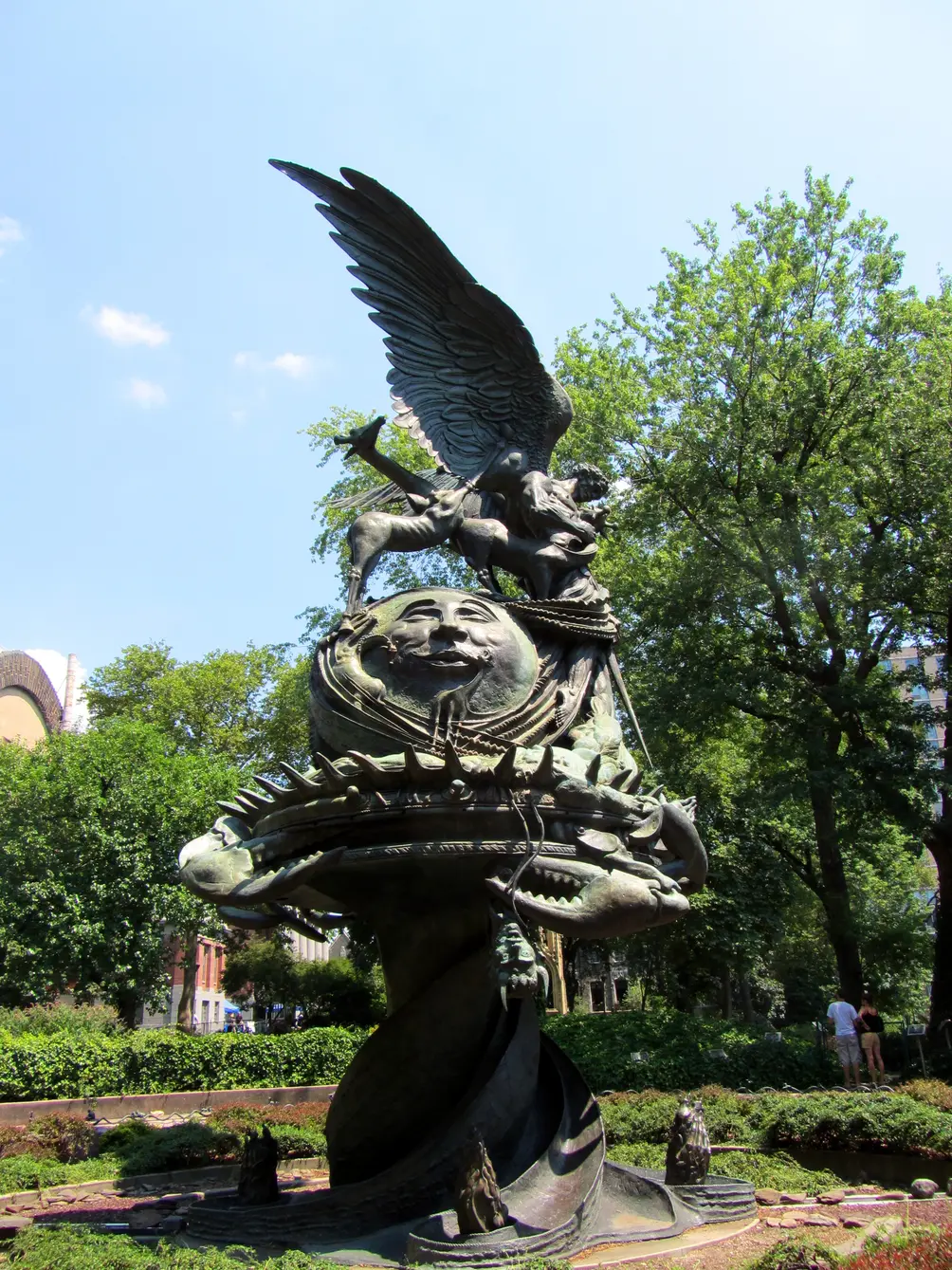 Image via Flickr user 'Loozrboy'
Image via Flickr user 'Loozrboy'
The Cathedral of St. John the Divine, home of several art exhibitions and the American Poets Corner, is temporarily closed. But the Peace Fountain on the grounds, sculpted in 1985 by Greg Wyatt, then-artist-in-residence, can still be admired. The 40’ sculpture uses several representations of the conflict between good and evil, the Archangel Michael’s defeat of Satan chief among them.
At the base of the sculpture, a series of small animal bronze sculptures at the base was created by K-12 students throughout the New York City area’s public, private, and parochial schools, and stands as a symbol of the diverse community the Cathedral strives to represent. The statue also depicts nine giraffes (said to be one of the most peaceable animals) as well as a lion lying down with a lamb.
At the base of the sculpture, a series of small animal bronze sculptures at the base was created by K-12 students throughout the New York City area’s public, private, and parochial schools, and stands as a symbol of the diverse community the Cathedral strives to represent. The statue also depicts nine giraffes (said to be one of the most peaceable animals) as well as a lion lying down with a lamb.
There are 31 copies of Non-Violence (also known as The Knotted Gun) in the world, and the original is in New York. Artist Carl Frederik Reuterswald originally sculpted the .357 Magnum revolver with its muzzle tied in a knot as a tribute to musician and peace activist John Lennon. One copy was originally located at Central Park’s Strawberry Fields (see below).
In 1988, Luxembourg donated the statue to the United Nations, and it was subsequently moved outside the headquarters; Secretary-General Kofi Anan described it as "a powerful symbol that encapsulates, in a few simple curves, the greatest prayer of man; that which asks not for victory, but for peace." The Non-Violence Project, a non-profit organization, adopted it as its symbol in 1993.
In 1988, Luxembourg donated the statue to the United Nations, and it was subsequently moved outside the headquarters; Secretary-General Kofi Anan described it as "a powerful symbol that encapsulates, in a few simple curves, the greatest prayer of man; that which asks not for victory, but for peace." The Non-Violence Project, a non-profit organization, adopted it as its symbol in 1993.
The meaning of art is ever-changing, and proof of that can be seen with The Sphere. When it was originally commissioned for the Austin J. Tobin Plaza in the original World Trade Center, the 25’ cast bronze sculpture by Fritz Koenig was designed to signify world peace through world trade. However, after it survived the attacks of September 11, 2001 largely intact, the sculpture took on new significance.
Immediately after the attacks, the sculpture was removed to a hangar at John F. Kennedy International Airport, and was temporarily re-erected in Battery Park on March 11, 2002, six months after the attacks. Thanks in part to the efforts of 9/11 families, it is now a permanent fixture in Liberty Park, overlooking the September 11 Memorial and the former World Trade Center site. Mr. Koenig has said, “It was a sculpture, now it’s a monument...It now has a different beauty, one I could never imagine.”
Immediately after the attacks, the sculpture was removed to a hangar at John F. Kennedy International Airport, and was temporarily re-erected in Battery Park on March 11, 2002, six months after the attacks. Thanks in part to the efforts of 9/11 families, it is now a permanent fixture in Liberty Park, overlooking the September 11 Memorial and the former World Trade Center site. Mr. Koenig has said, “It was a sculpture, now it’s a monument...It now has a different beauty, one I could never imagine.”
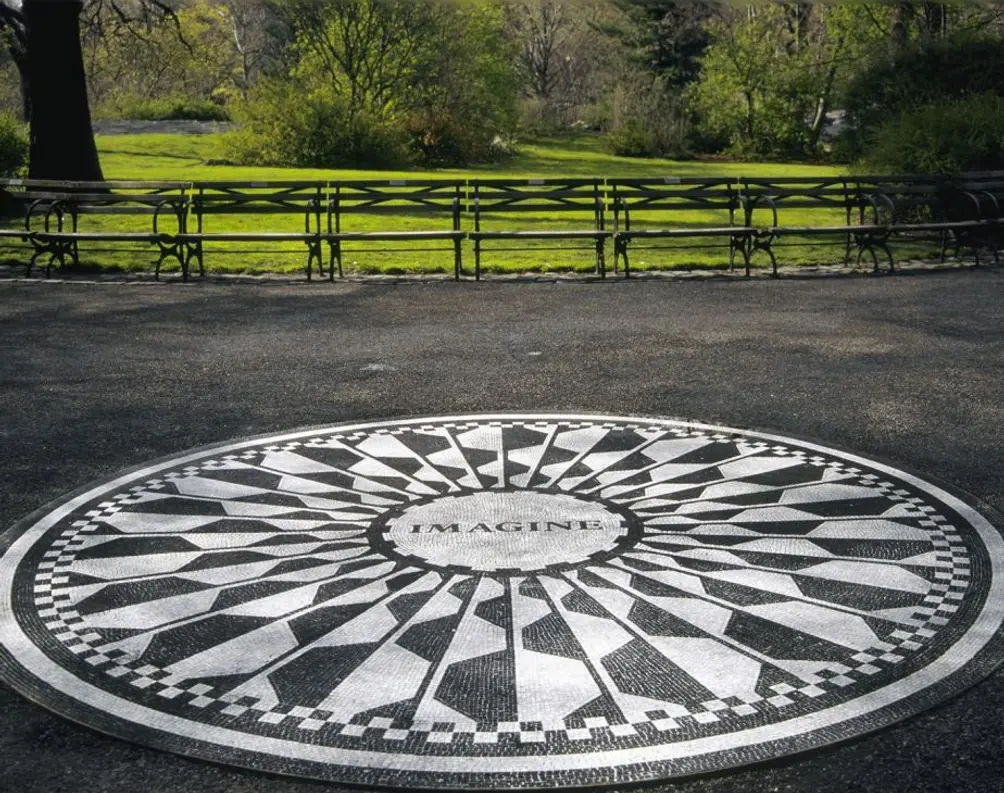 Strawberry Fields via Central Park
Strawberry Fields via Central Park
When John Lennon lived at The Dakota, an adjacent section of Central Park was a favorite of his. Shortly after his death, City Council Member Henry J. Stern designated the area “Strawberry Fields” in honor of the Beatles song, and the re-landscaped area officially reopened on October 9, 1985 (the 45th anniversary of Lennon’s birth). Today, the 2.5-acre “quiet zone” is home to the world-famous “Imagine” mosaic and flowers planted by more than 120 countries.
Ralph Ellison is one of Harlem’s literary luminaries, and the monument to honor him was inspired by his most famous work, Invisible Man: A 15’ x 10’ bronze monolith features the hollow silhouette of a man, and the monument also features a biographical panel and two granite panels inscribed with Ellison quotes.
African-American artist Elizabeth Catlett was chosen through an art competition held by the Riverside Park Fund and the Ralph Ellison Memorial Commission, some of whom knew Mr. Ellison personally. The monument is located along Riverside Drive and West 150th Street, and was unveiled in 2003.
African-American artist Elizabeth Catlett was chosen through an art competition held by the Riverside Park Fund and the Ralph Ellison Memorial Commission, some of whom knew Mr. Ellison personally. The monument is located along Riverside Drive and West 150th Street, and was unveiled in 2003.
In the early years of the United Nations, the leadership of its first-ever Secretary-General, Trygve Lie, was instrumental in establishing its mission of promoting world peace and fundamental human rights. He was also in charge of establishing its headquarters in Manhattan.
Decades later, the centerpiece of his namesake plaza at First Avenue between East 41st and 42nd Streets is an abstract work by Lina Viste Gronil that pays tribute to his aspirations for peace. The Peace Clock does not tell time in a traditional manner, but its hands align to assume the position of the peace sign twice a day.
Decades later, the centerpiece of his namesake plaza at First Avenue between East 41st and 42nd Streets is an abstract work by Lina Viste Gronil that pays tribute to his aspirations for peace. The Peace Clock does not tell time in a traditional manner, but its hands align to assume the position of the peace sign twice a day.
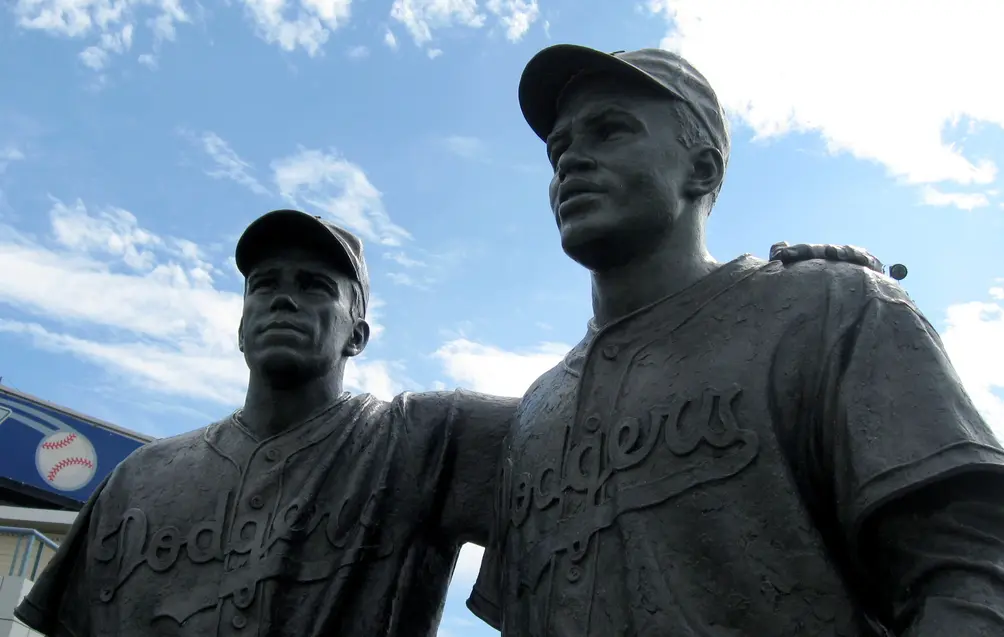 via John from Flickr
via John from Flickr
Baseball season may be on hold, but a powerful work can still be seen at the entrance to MCU Park, home of the Brooklyn Cyclones. A sculpture by William Behrends, an artist known for his portraits of professional players, depicts Brooklyn Dodgers Jackie Robinson and Pee Wee Reese. Early in Robinson’s career, Reese showed public support for him in the face of racial taunts and death threats. The two were friends on and off the field, and the simple gesture of friendship took on extra significance with broader implications for social progress. The monument was dedicated in November 2005 with Robinson and Reese’s widows, as well as some former Dodgers teammates, in attendance.
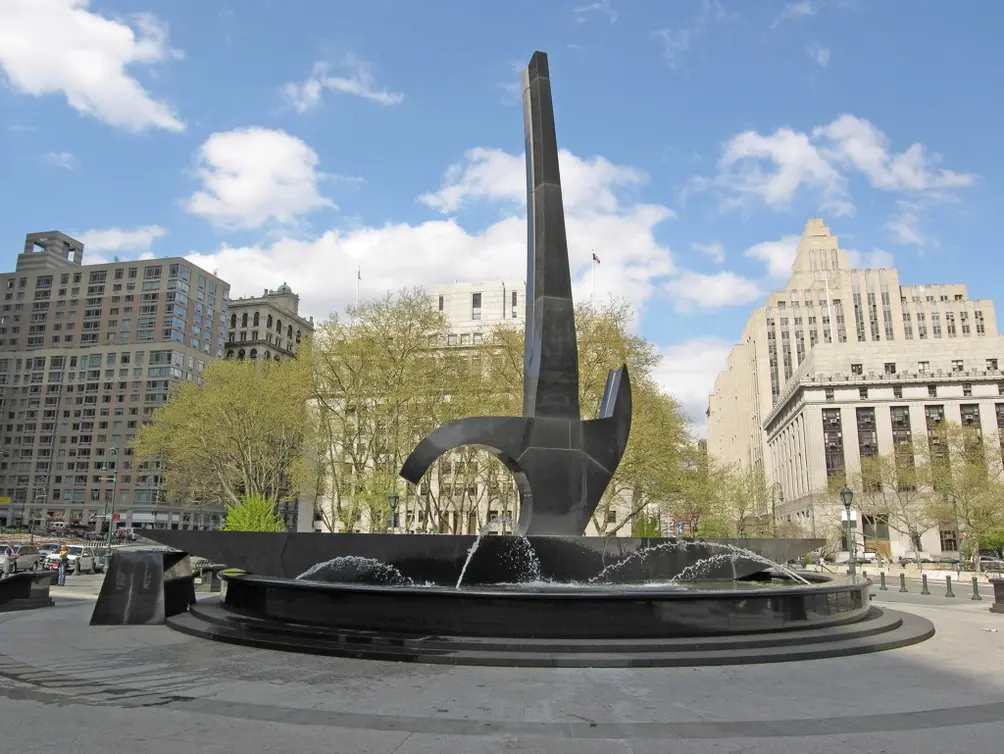 Triumph of the Human Spirit via Lorenzo Pace
Triumph of the Human Spirit via Lorenzo Pace
In 1991, construction workers excavating the foundation for a federal office building at 290 Broadway came across the intact remains of over 400 persons, long ago interred at the Colonial-era African Burial Ground, which was later subsumed by centuries of development. Following an extensive archeological survey, a portion of the site was preserved as a National Historic Landmark, and the area from the southern portion of Foley Square to the northern precinct of City Hall Park was designated the New York City African Burial Ground and Commons District.
Triumph of the Human Spirit, a massive granite sculpture by Dr. Lorenzo Pace, stands at the heart of it. The piece was inspired by "Chi Wara," an antelope effigy from West Africa symbolizing responsibility for continuing the next generation. It is set in an elongated, boat-like structure that resembles a canoe.
Triumph of the Human Spirit, a massive granite sculpture by Dr. Lorenzo Pace, stands at the heart of it. The piece was inspired by "Chi Wara," an antelope effigy from West Africa symbolizing responsibility for continuing the next generation. It is set in an elongated, boat-like structure that resembles a canoe.

 6sqft delivers the latest on real estate, architecture, and design, straight from New York City.
6sqft delivers the latest on real estate, architecture, and design, straight from New York City.
